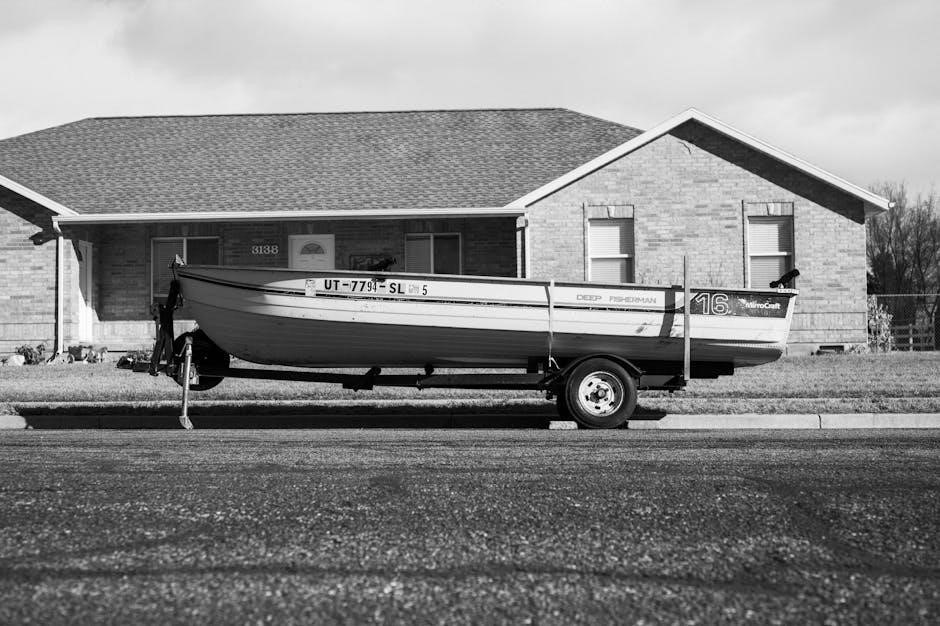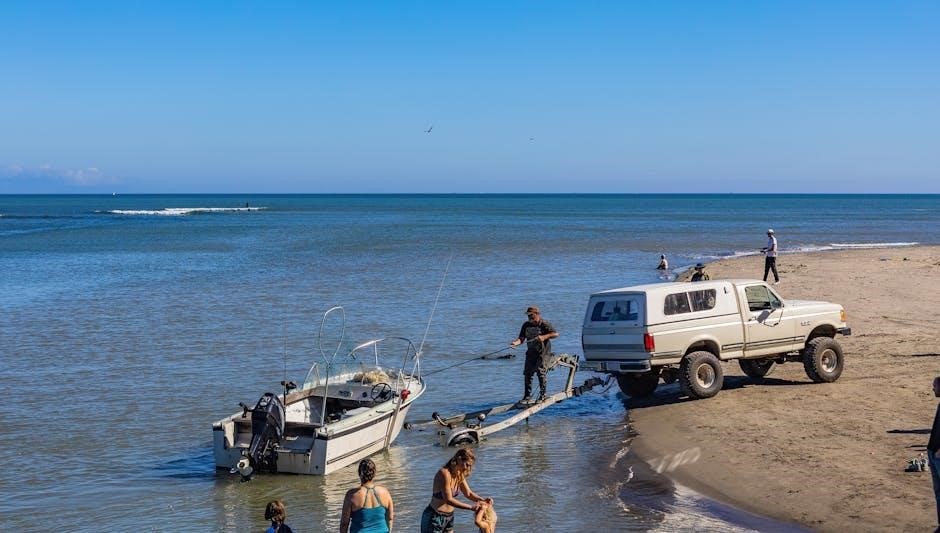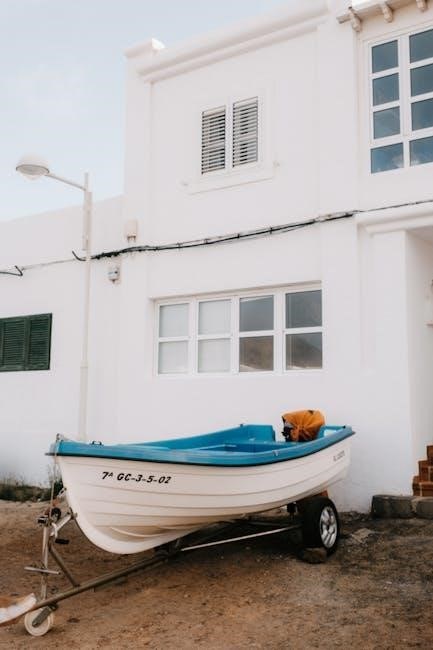Boat trailer guides are essential tools for safe and efficient boat handling. They help align and stabilize the boat during loading and launching, ensuring proper positioning.
What Are Boat Trailer Guides?
Boat trailer guides are devices designed to assist in aligning and stabilizing a boat during loading and launching. Typically mounted on the trailer, they help center the boat and prevent it from drifting off course. These guides can be made of materials like PVC, metal, or aluminum and come in various styles, such as roller, post, or adjustable systems. They enhance safety by reducing the risk of damage to the boat or trailer and make the process of launching and retrieving the boat more efficient, especially in challenging conditions like strong winds or currents.
Why Are Boat Trailer Guides Important?
Boat trailer guides are crucial for ensuring safe and efficient boat handling. They minimize the risk of damage to both the boat and trailer by maintaining proper alignment during loading and launching. Guides also reduce the effort required to maneuver the boat, especially in windy or current-prone environments. Additionally, they help prevent the boat from veering off course, which can save time and frustration. Overall, trailer guides enhance the towing experience, making it safer and more convenient for boat owners to enjoy their time on the water without unnecessary stress or complications.

Types of Boat Trailer Guides
Boat trailer guides come in various types, including roller, post, and adjustable models. Each design offers unique benefits, ensuring secure and aligned boat loading and launching processes.
Roller Guides
Roller guides are a popular choice for boat trailers, offering smooth and effortless boat loading. They feature rollers that cradle the boat hull, reducing friction and preventing damage. These guides are ideal for frequent use, as they minimize wear on both the boat and trailer. Roller guides are especially useful in windy or current-heavy conditions, providing stability and control. They are durable, with rust-resistant coatings, and come in various sizes to fit different boat and trailer setups. Regular maintenance ensures optimal performance, making them a reliable option for boat enthusiasts.
Post Guides
Post guides are simple, effective, and widely used for boat trailers. Typically L-shaped, they are available in various widths and heights, ranging from 40 to 60 inches. Made from durable materials like PVC or metal, these guides provide clear visual alignment, helping to center the boat on the trailer. They are easy to install and adjust, offering stability during loading and launching. Post guides are especially useful in windy or low-visibility conditions, ensuring the boat stays aligned. Their rust-resistant coatings and adjustable designs make them a practical choice for long-term use, enhancing safety and efficiency for boat owners of all experience levels.
Adjustable Guides
Adjustable guides offer versatility for boat trailers, allowing customization to fit various boat sizes and trailer setups. These guides can extend up to 19 inches on each side, accommodating different frame widths and heights. Made from durable materials like pre-galvanized steel, they ensure long-lasting performance. Adjustable guides are easy to install and come with mounting hardware, providing a secure fit. Their flexibility makes them ideal for trailers that need to handle multiple boats or varying conditions, ensuring proper alignment and stability during loading and launching. This adaptability enhances safety and efficiency, making adjustable guides a practical choice for boat owners seeking convenience and reliability.

Materials and Durability
Boat trailer guides are crafted from durable materials like PVC, steel, and aluminum, ensuring resilience against harsh marine environments. Rust-resistant coatings and galvanized finishes enhance longevity and performance.
PVC vs. Metal Guides
PVC guides are lightweight, corrosion-resistant, and ideal for freshwater use, offering a lower cost. Metal guides, made from steel or aluminum, provide superior durability and strength, suitable for heavy boats and saltwater environments. PVC guides are easier to install and maintain, while metal guides require rust-proof coatings but last longer. Choosing between them depends on boat size, usage frequency, and environmental conditions. Both options ensure safe and efficient boat loading and launching, with PVC being a budget-friendly choice and metal offering long-term reliability.
Steel and Aluminum Options
Steel and aluminum are popular materials for boat trailer guides due to their durability and strength. Steel guides offer superior rigidity and load-bearing capacity, making them suitable for heavy boats, while aluminum guides are lightweight and resistant to corrosion, ideal for freshwater and saltwater use. Both materials are available in various finishes, such as galvanized steel for rust resistance and anodized aluminum for enhanced durability. Proper maintenance, including regular cleaning and lubrication, ensures longevity. Steel guides are often preferred for their strength, while aluminum guides provide ease of handling and corrosion resistance, making them a practical choice for many boat owners.
Rust-Resistant Coatings
Rust-resistant coatings are crucial for boat trailer guides, especially in saltwater or humid environments. These coatings protect metal components from corrosion, ensuring durability and longevity. Galvanized steel guides are a popular choice, as they feature a zinc layer that resists rust. Aluminum guides naturally resist corrosion but may still benefit from protective finishes. Regular cleaning and applying rust-inhibiting sprays can further enhance protection. Durable coatings not only maintain the structural integrity of the guides but also reduce maintenance needs, ensuring reliable performance during loading and launching. Investing in rust-resistant coatings is essential for extending the lifespan of your boat trailer guides.

Installation and Adjustment
Installing boat trailer guides involves attaching guide posts to the trailer frame, ensuring they are level and secure. Adjustments are made to align the guides with the boat’s width and height, ensuring proper fit and safe loading. Correct installation and precise alignment are crucial to avoid damage and ensure smooth operations during loading and launching.
How to Mount Guide Posts
Mounting guide posts involves attaching them securely to the trailer frame. Ensure the posts are vertically aligned and evenly spaced to match the boat’s width. Use pre-drilled holes or weld-on brackets for installation. Tighten all bolts firmly to prevent movement. Adjust the height to align with the boat’s hull, ensuring stability. Proper alignment is crucial for safe loading and launching. Guide posts should be sturdy and level to provide reliable support. Always follow manufacturer instructions for specific mounting requirements to ensure a secure fit and optimal performance during boat handling.
Aligning the Trailer for Proper Fit
Aligning the trailer for proper fit is crucial for safe and efficient boat loading. Position the trailer in the water at the correct depth, ensuring the bunks or rollers align with the boat’s hull. Use guide posts or rollers to center the boat as it floats onto the trailer. Adjust the trailer’s angle to match the boat’s approach, ensuring even contact. Proper alignment prevents damage and ensures the boat sits securely. Guide posts help maintain straight alignment, especially in windy or current conditions. Once aligned, slowly drive or winch the boat onto the trailer until it rests firmly against the stop.
Adjusting Guide Height and Width
Adjusting the height and width of trailer guides ensures a proper fit for your boat. Measure the boat’s beam to determine the ideal guide width, typically slightly wider than the hull. Raise or lower the guides to align with the boat’s sides, ensuring even contact. Tighten the adjustment bolts securely after positioning. For adjustable models, extend or retract the arms to center the boat on the trailer. Proper alignment prevents wobbling and improves stability during transport. Regularly check and adjust the guides to accommodate different loading conditions or boat configurations, ensuring safe and efficient trailer performance every time.

Using Trailer Guides for Loading and Launching
Trailer guides simplify loading and launching by aligning the boat with the trailer. They enhance stability, reduce effort, and ensure safe, efficient water entry and retrieval.
Aligning the Trailer with the Boat Ramp
Proper alignment of the trailer with the boat ramp is crucial for smooth loading and launching. Position the trailer so it is straight and centered on the ramp. Use guide posts or visual markers to help gauge the trailer’s position relative to the ramp. Ensure the trailer is submerged to the recommended depth, allowing the boat to float or drive onto the bunks evenly. Misalignment can lead to poor loading or damage, so take time to adjust the trailer’s angle and position carefully before proceeding. Proper alignment ensures a safer and more efficient process for both loading and launching.

Guiding the Boat onto the Trailer
Guiding the boat onto the trailer requires precision and control. Once the trailer is properly aligned and submerged, slowly maneuver the boat towards the center of the trailer. Use guide posts or rollers to help direct the boat’s movement; Maintain a steady speed and ensure the boat is centered as it moves onto the bunks. If using a motor, apply gentle power to avoid surging. If manually guiding, have someone assist to ensure proper alignment. Proper guidance ensures the boat is securely positioned, making the process safer and more efficient while minimizing the risk of damage to the boat or trailer.
Launching the Boat into the Water
Launching the boat into the water requires careful preparation and alignment. Ensure the trailer is properly positioned with guide posts or rollers to facilitate a smooth exit. Reverse the trailer into the water until the boat begins to float. Check the water depth to prevent submerging the trailer too deeply, avoiding damage or rust. Once afloat, detach the boat and maneuver it away. This process ensures a safe, efficient launch, minimizing risks and damage, while the guides enhance control and precision.

Maintenance and Care
Regular cleaning and lubrication of boat trailer guides are crucial to ensure smooth operation. Inspect for rust or wear and protect with rust-resistant coatings for durability.
Cleaning and Lubricating Guides
Cleaning and lubricating boat trailer guides are vital for optimal performance. Use a portable sprayer with water and a product like Salt Off to remove dirt and salt residue. Regularly inspect and clean guide posts to prevent corrosion. Lubricate moving parts with marine-grade lubricants to ensure smooth operation. Avoid using harsh chemicals that may damage materials. For metal guides, apply rust-resistant coatings after cleaning. PVC guides can be wiped down with mild soap and water. Regular maintenance ensures longevity and reliability, especially in salty or humid environments. Keep guides free from debris to maintain proper alignment during loading and launching.
Inspecting for Damage or Wear
- Regularly inspect trailer guides for signs of rust, especially on metal components, to prevent corrosion.
- Check guide posts for straightness and ensure they are not bent or dented from use or accidents.
- Examine PVC guides for cracks or excessive wear that could compromise their stability.
- Look for loose mounting hardware and tighten as needed to maintain proper alignment.
- Inspect for damage caused by excessive force or improper use during loading and launching.
- Lubricate moving parts to ensure smooth operation and prevent wear.
- Clean guides regularly to remove dirt and salt residue, which can lead to premature deterioration.
- Replace any worn-out components promptly to maintain safety and efficiency.
Protecting Against Corrosion
Corrosion is a major threat to boat trailer guides, especially in marine environments. Regular cleaning and lubrication can help prevent rust and extend the lifespan of metal components. Applying rust-resistant coatings or galvanized layers to steel parts is highly effective. For PVC guides, ensure they are free from dirt and salt residue, as these can accelerate wear. Store the trailer in a dry place when not in use and consider using covers to protect guide posts. Inspect and replace any corroded parts promptly. Proper maintenance will keep your trailer guides functional and reliable for years.

Safety Tips and Best Practices
Ensure proper tire pressure before towing to maintain control. Always secure the boat to the trailer with straps and check guide posts for stability in windy conditions.
Ensuring Proper Tire Pressure
Proper tire pressure is critical for safe towing and trailer stability. Check pressure before each trip using a reliable gauge, ensuring it matches the manufacturer’s recommendations. Under-inflation can lead to uneven tire wear, reduced fuel efficiency, and increased risk of blowouts. Over-inflated tires may compromise traction, especially when maneuvering heavy loads. Always refer to your trailer and vehicle owner’s manuals for specific guidelines. Regular checks help maintain optimal performance and safety while towing your boat, ensuring a smooth and controlled journey to and from the water.
Securing the Boat to the Trailer
Securing the boat to the trailer is vital for safe transportation. Use high-quality straps or tie-downs to ensure the boat remains stable and centered. Tighten the winch strap firmly but avoid over-tightening, as this can damage the hull. Additionally, use transom straps to secure the stern and prevent shifting during transit. For extra safety, consider installing a winch lock to prevent theft. Regularly inspect straps for wear and tear, replacing them as needed. Properly securing the boat ensures a smooth journey and protects your investment from potential damage caused by movement during towing.
Using Guide Posts in Windy Conditions
Boat trailer guides are invaluable in windy conditions, providing stability and control during loading and launching. The L-shaped design helps keep the boat aligned, even when strong winds or currents push it off course. Adjustable guide posts allow customization to fit various boat sizes and ramp angles, ensuring precise alignment. For enhanced visibility, especially in low-light conditions, consider unlit or illuminated posts. Regular maintenance, such as lubricating hinges and inspecting for damage, ensures smooth operation. By securing the boat with guide posts, you minimize the risk of misalignment and damage, making the process safer and more efficient, even in challenging weather.
Boat trailer guides enhance loading and launching efficiency, ensuring safety and reducing damage. They are indispensable for smooth operations, especially in windy or low-visibility conditions, protecting both boat and trailer.
The Benefits of Trailer Guides
Trailer guides offer numerous advantages for boat owners. They simplify the loading and launching process, reducing stress and saving time. By providing clear alignment, they prevent damage to both the boat and trailer. Guides also enhance stability, especially in windy or current-prone environments, ensuring safer operations. Additionally, they help maintain proper positioning, preventing the boat from shifting during transit. This makes them an invaluable accessory for both experienced and novice boaters, improving overall efficiency and confidence when handling the vessel.
Overall, trailer guides are a practical investment for anyone seeking to streamline their boating experience.
Final Thoughts on Choosing the Right Guides
Selecting the right trailer guides is crucial for a seamless boating experience. Consider factors like durability, adjustability, and material compatibility with your trailer and boat. PVC guides offer corrosion resistance, while metal guides provide strength. Adjustable options ensure versatility for different boat sizes or conditions. Proper installation and regular maintenance are key to longevity and performance. By investing in high-quality guides tailored to your needs, you can enhance safety, efficiency, and overall satisfaction. Research and compare products to find the best fit for your specific setup and ensure reliable performance.
Make an informed decision to optimize your boating adventures.

Additional Resources
Explore online tutorials and forums for DIY modifications and expert advice on boat trailer guides. Visit retailers like CE Smith for high-quality products and detailed guides to enhance your setup.
Where to Buy Trailer Guides
Trailer guides are widely available from marine supply stores, online retailers, and manufacturer websites. Popular options include CE Smith, which offers durable guides, and retailers like Amazon or eBay for convenience. Visit specialized boating stores for expert advice or check online marketplaces for a variety of styles and brands. Ensure to purchase from reputable sources to guarantee quality and compatibility with your trailer. Always review product descriptions and customer reviews before making a purchase to find the best fit for your needs.

Online Tutorials and DIY Modifications
Online tutorials and DIY guides offer step-by-step instructions for installing or modifying boat trailer guides. YouTube and forums feature videos on fabricating custom guide posts using PVC or metal. DIY modifications, such as extending brackets or adding LED lights, enhance functionality. Many enthusiasts share budget-friendly solutions, like repurposing materials for guide systems. Websites provide plans for building adjustable guides or improving existing ones. These resources empower boat owners to customize their trailers for better performance. With basic tools like drills and saws, users can create durable, tailored guide systems, ensuring a perfect fit for their boats.